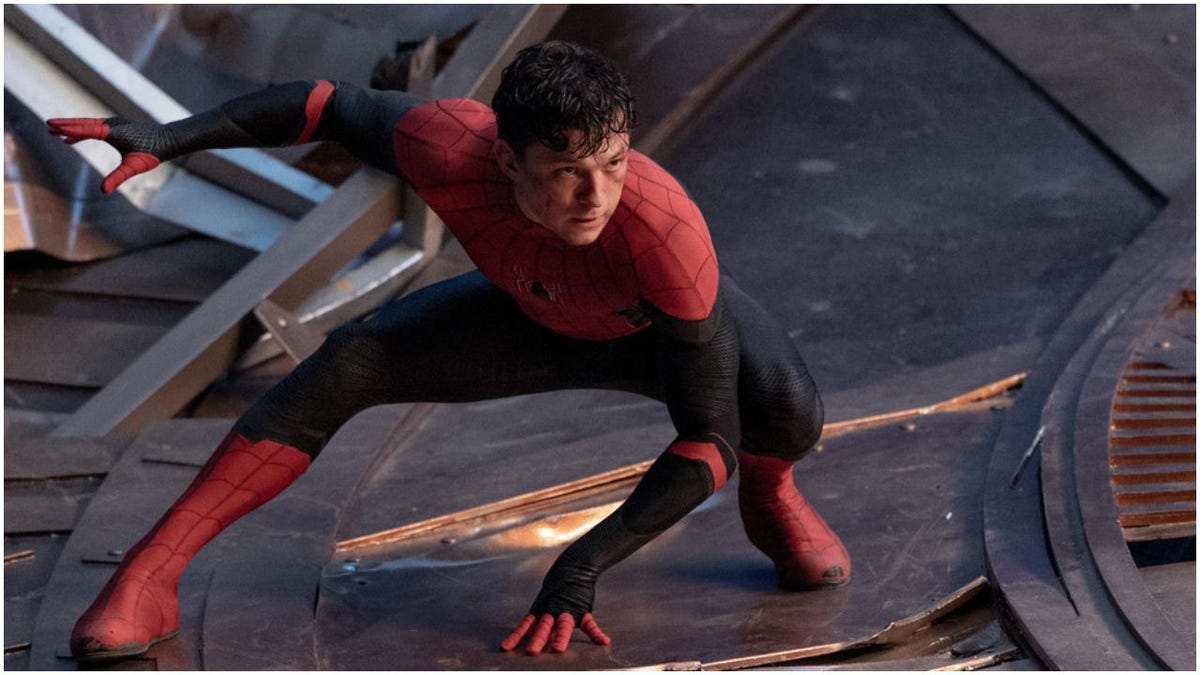In superhero movies, it’s a given that the good guys will try to save innocents from the bad guys. Sometimes they save individuals, sometimes they save cities, and all too often—especially in the Marvel Cinematic Universe (MCU)—they save the entire planet or, increasingly, the entire universe. (Once you’ve raised the stakes so high and swatted them back down, every subsequent threat on that scale seems less threatening because more unreal.)
But what if the good guys tried to save the bad guys from themselves?
That’s the question raised by Spider-Man: No Way Home, the first COVID-era blockbuster, which not only brings the current Spider-Man trilogy to a satisfying close (while leaving the door open to future movies, of course), but unites all three of the live-action Spider-Man movie franchises—and in the process tries to redeem some of their villains.
Spider-Man: No Way Home isn’t entirely breaking new ground here; the potential for redemption was always there in the other films. Unlike the power-hungry General Zods or the nihilistic Jokers of the Superman and Batman movies, the villains in Spider-Man films have tended to be tragic figures whose good intentions went awry. In some cases—Doctor Octopus in 2004’s Spider-Man 2, Harry Osborn in 2007’s Spider-Man 3—the antagonists have even switched sides in the final act and sacrificed their lives to help Spider-Man and his friends.
In the new film—and for reasons too complicated to get into here—several of these villains are yanked out of their worlds and deposited in the MCU, where Spider-Man, aka Peter Parker, is now a high school student played by Tom Holland. Peter has to send all the villains back to their worlds, but when he learns that most of them were yanked out before they died—effectively, they were yanked out of the middle of their respective movies—he decides he has to save them by “fixing” the chemical, electrical, or cybernetic accidents that brought out their darker sides. He won’t just leave them to their fates.
One or two of these characters welcome the chance to be “cured.” But Norman Osborn, aka the Green Goblin (Willem Dafoe, who finally gets to let his face and not a mask do the menace-projecting), fights back and persuades most of the others to fight back, too. And because Peter got some of his moral inspiration from his Aunt May (Marisa Tomei), who works at a charity for the homeless, the Green Goblin makes a point of killing her. “You tried to fix me,” he tells Peter before striking the fatal blow. “Now I’m going to fix you.”
And so the film raises questions that go even deeper than the basic redemption theme, namely: What is the source of our morality? Is it something programmed into us, whether by nature or nurture? Or is it something we choose, for better and for worse?
While the Spider-Man movies have featured the occasional villain who actively chooses to be evil—Spider-Man 3’s Eddie Brock comes to mind, and he is noticeably absent from the proceedings here—they have always played heavily on the idea that villains are “made” by external factors: a chemical compound that increases aggression, a fried computer chip that allows “smart” robot arms to override a person’s higher brain function, and so on.
Sometimes the films have underlined the idea that those darker impulses were always there, that the potential for evil lurks within all of us, and that the external factors simply made it easier to give in to those impulses; even Peter Parker succumbs to Venom’s influence in Spider-Man 3. Sometimes the point is made that people like Norman Osborn and Dr. Otto Octavius (Alfred Molina), aka Doctor Octopus, were blinded by hubris when they invited these external factors into their lives.
But still, given how these movies have tended to portray villains as victims of outside forces, it makes sense that this movie’s Spider-Man talks about “fixing” those villains, as if to say that basic goodness is a person’s natural state, being bad is not something a person would choose, and all you have to do to make someone good is remove that outside influence.
But not so fast. The Green Goblin challenges this line of thought by asserting that Peter Parker’s goodness is, itself, the product of an outside influence. He says Peter has been “trapped” in Aunt May’s “holy moral mission,” but now he’s going to free Peter from that trap.
The question that hangs over the rest of the film is whether Peter will respond to the death of his aunt the way the Goblin expected, or whether he can prove the Goblin wrong by actively choosing a higher moral path. And it’s at this point that Tom Holland’s Peter Parker is visited by the Peter Parkers of the other films (played by Tobey Maguire and Andrew Garfield), both of whom have had to deal with grief and loss in their own ways, and both of whom agree to help the Peter Parker of this universe save the bad guys from their universes.
So one Peter Parker gets moral support from the other Peter Parkers. But this just raises yet another question: Where does any Peter Parker get his morality from?
In the Tobey Maguire films, it was strongly implied that he got it from his Catholic upbringing; Parker himself professed no faith, but his Uncle Ben and Aunt May quoted the Bible, said their prayers, and thanked the angels (or statues of angels) that came to their rescue. What’s more, director Sam Raimi set key scenes in or near churches, which lent a religious dimension to his morality tales. (Not for nothing does one of the other Spider-Men say Maguire’s Peter Parker is dressed like a “cool youth pastor” in the new movie.)
The Peter Parkers played by Andrew Garfield and Tom Holland are less clearly defined, and they seem to have had more difficulty overcoming their darker sides. Garfield’s Parker says, in the new film, that he got bitter and angry and stopped pulling his punches after his girlfriend fell to her death in his last film (the fact that he saves Holland’s Parker’s girlfriend from a similar fate in this film is another of the second chances that the film gives its characters). And while Holland’s Parker doesn’t blame any of the other villains for his Aunt May’s death, he comes very close to killing Norm Osborne before Maguire’s Parker intervenes.
In the end, Holland’s Parker makes the right choice, gives Norman Osborn the stuff that brings him back to his senses, and sends everyone back to their worlds. (Which of course leaves fans to ponder all the various plot holes—like, if the villains were yanked out of the middle of each movie but the Spider-Men were yanked out of their universes years after their movies ended, are the villains and the Spider-Men who saved them being sent back to the same timelines now?)
And if I may get deeper into the MCU weeds for a minute: If Holland continues to play Peter Parker, the issue that future Spider-Man films will have to deal with is how his Spidey becomes a hero in his own right. Holland has now played the character in six films—three solo efforts, two Avengers movies, and the Captain America movie that first introduced him in the role—and in all of them, he has either lived in Iron Man’s shadow or, in the new film, found his strength by teaming up with the Spider-Men that came before him.
Still, it’s remarkable how this film offers something quite different from the usual us-versus-them triumphalism. There’s a scene in the new film where the Spider-Men are going about their plans and M.J. (Zendaya), the girlfriend to Holland’s Peter Parker, says, “We’re going to kick some ass.” To which one of the Spider-Men replies, “Cure. We’re gonna cure some ass.” Now that’s a sentiment to lift all our spirits.

